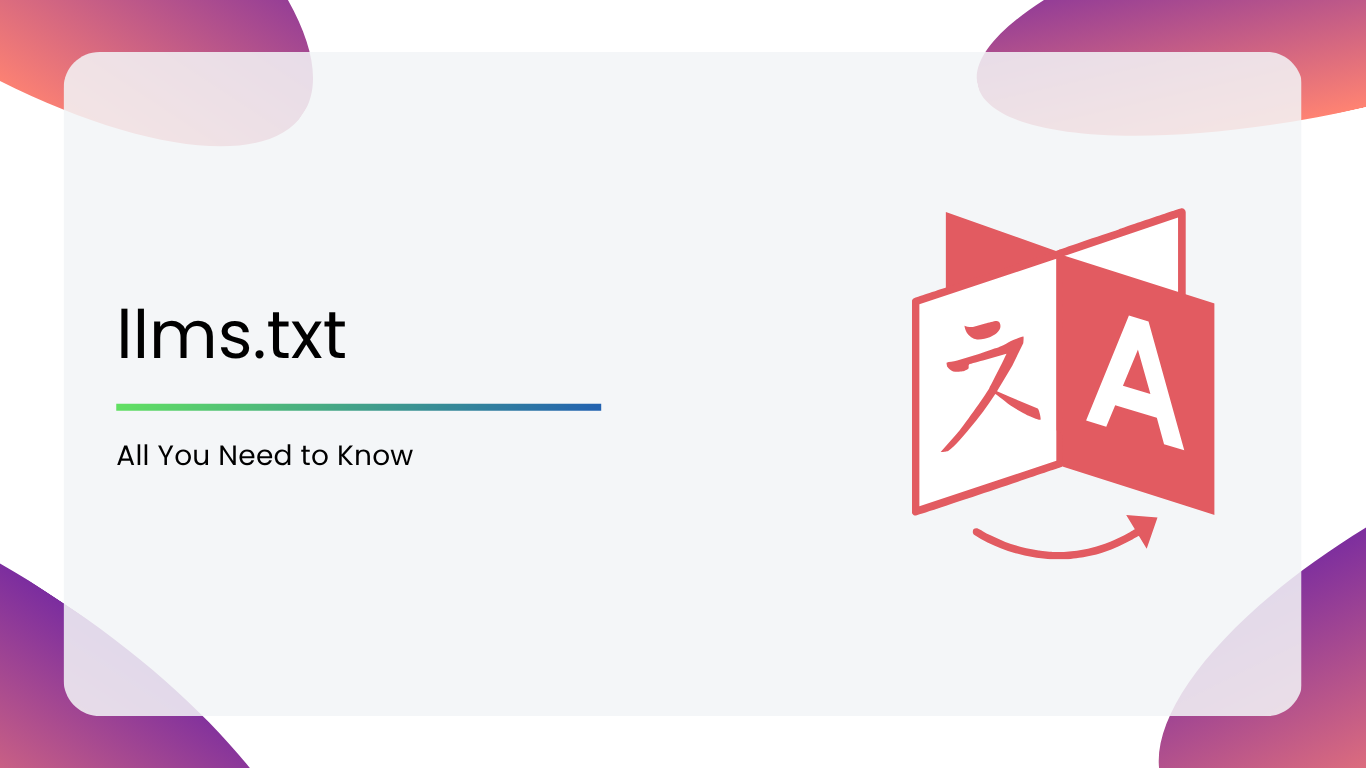LLMs, or Large Language Models, are rapidly transforming the online information landscape by becoming the go-to for modern users to find accurate answers to their search queries. This shift is so significant that Gartner predicted traditional search engine traffic would drop by 25% as users are moving toward AI interfaces to seek information over keyword searches.
What is LLMS.txt?
Llms.txt is a special text file that allows AI systems and language models to understand and process the content of websites more accurately and efficiently.
It’s well known that most web content is built on HTML, which is constructed from large, complex structures, including navigation menus, advertisements, and JavaScript. This often makes it hard for AI systems to access and process the content. When located in the root directory of your website, the LLMS.txt file aims to cut through the noise, keeping data simple, clear, and accessible to AI systems.
HTML vs LLMs: Are Traditional Websites Enough?
Today, websites aren’t designed only for humans but also for LLMs. Yet traditional web structures like HTML, sitemaps, and robots.txt are not optimized for AI. This discrepancy creates challenges for LLMs like:
- Ambiguous context construction: When an LLM tries to seek context for a website, it faces trouble prioritising what content to retrieve. It doesn’t provide clarity on whether it needs to crawl every page on the sitemap, whether it needs to include external links, or even incorporate source codes for specific domains such as software documentation.
- Conciseness and Clutter: While LLMs can process a large volume of data quickly, they prefer concise content, just like a human reader would. HTML, which is designed for browsers, usually bears extra code and “noise,” including navigation menus, JavaScript, cookie popups, ads, etc. This noise wastes tokens within an LLM’s limited context window, making it hard for the AI to find the most valuable content available.
- Outdated or Misinformed Responses: Web clutter prevents LLMs from properly discerning important content. LLMs tend to scan only small parts of a website in real time, which results in outdated, incomplete, or outright incorrect AI responses about a brand, product, or service.
- Site Authors Know Best: Site authors are best positioned to identify high-value content and provide a curated list of content that LLMs should use. Llms.txt expedites this process.
LLMS.txt vs Robots.txt: Are They the Same?
| Key Metrics | Llms.txt | Robots.txt |
| Primary Purpose | Allows AI systems and language models to better understand and process website content. | Controls how search engine bots crawl a site |
| Main Function | Helps AI understand and prioritise your content. | Allows or prevents access to content for bots |
| Target Audience | Large Language Model-based AI systems (ChatGPT, Claude, Gemini, etc.) | Search Engine Bots (GoogleBot, BingBot, etc.) |
| Format | Markdown | Plain text |
| Uses in SEO | Increases visibility of a site through AI optimisation (GEO – Generative Engine Optimisation) | Redirection through control of how search engines crawl through a site |
Llms.txt cannot restrict AI models from training on your content or scraping data, as that still falls under the purview of robots.txt, HTTP headers, or opt-out metadata. You can view llms.txt and robots.txt as collaborators instead of competitors. Use the best of both to build a smarter, AI-optimized website.
How LLMS.txt Is Important For SEO and Marketing:
- Citations in AI-Generated Answers: LLMs don’t work like search engines do by crawling and ranking. They interpret, consolidate, and generate content. If they are unable to find clear, relevant content about your brand, it opens your brand and its messaging up to the risk of misinterpretation, misinformation, or worse, omission.
- Optimises Website Structure: Websites are built keeping browsers and the human eye in mind, which can overwhelm or confuse an AI. Llms.txt provides a simple, structured view of your best content to an AI model by removing the friction caused by layers of widgets.
- AEO and GEO: Llms.txt builds on optimising your content so that it not only shows up in search results but also in the quick summarized results offered by AI. Boosting both AI visibility and ranking on search engines allows your content to shine.
- Used by major AI platforms: LLM providers are already decoding LLMs.txt files and are in use by AI systems like Claude, Zapier, OpenPipe, etc. Capitalising on LLM optimisation is very important, as ignoring llms.txt now would mean missing out on increased visibility where and when relevant.
- Control AI’s narrative: LLMs pull data from whatever scraps they’re able to find and process – outdated documents, scraped pages, and forums. Using llms.txt prevents AI hallucinations, keeps messaging precise, and positions your content and brand as trustworthy.
- Supports your internal tools: If your company uses internal LLMs for tasks like product documentation, customer service, or knowledge search, even these require clear, organized input just as much as public AI platforms do.
- Complements existing SEO strategy: Llms.txt is fast becoming a core aspect of AI visibility. It means your content is understood, trusted, and cited by AI-generated conversations. This, in turn, leads to greater brand control and a stronger presence in the next phase of online visibility.
- Easy to create: It takes less than an hour to create a basic llms.txt. The most minimal version of llms.txt gives you a starting point for navigating GEO. You can also scale it like you would a sitemap or schema file over time, as per your requirements.
Creating An LLMS.txt File: A Complete Guide
Step 1: Identify high-priority content
Figure out which parts of your website add value and are important for AI to understand, such as product pages, company information, policies, and so on.
Step 2: Create or reuse markdown versions of these pages
Consider converting high-value pages into markdown documents if your content exists only as HTML
- Strip away design elements, ads, banners, and navigation.
- Concentrate on brief, factual content.
- Make sure to use proper markdown formatting, # for headings, – for bullet points, [link text] (url) for links.
Step 3: Write a clear, effective summary of your site.
Include a summary of your brand or website at the top of your llms.txt file. This provides context for LLMs before they explore individual sections of content. The format is as follows:
# [Brand Name]
> [1-2 sentence summary of what your brand does, who it helps, and why it matters]
Example:
# Smacient
> A platform that helps individuals and businesses grow and enhance productivity and efficiency with our suite of AI tools.
Step 4: Structure content into organized categories
Use ## headers to break content into logical sections. This helps LLMs prioritise search based on context and query type.
Example sections:
- ## Docs – used for technical docs, API guides, help articles
- ## Product – used for feature pages or product summaries
- ## Policies – used for terms, privacy, return/refund, legal
- ## Support – used for contact info, onboarding, or troubleshooting
- ## Optional – used for secondary content if context window is tight
Each section should include a bullet point list of relevant resources, like this:
## Product
– [Pricing](https://yourdomain.com/pricing.md): Overview of pricing tiers, features, and billing policies.
Step 5: Save the file and upload it to the root directory
The file must be hosted at:
https://yourdomain.com/llms.txt
If you’re using a “full” version that includes flattened content, make sure to name it:
https://yourdomain.com/llms-full.txt
You can also use both:
- llms.txt for a compiled map of content
- llms-full.txt for raw, full-site flattened text (It works like a text dump of your documents)
Step 6: Add contextual metadata
Some developers include:
- Timestamps
- Version info
- Token estimates for each file
This helps AI frameworks decide what to load or skip based on query type.
Example:
– [API Docs](https://yourdomain.com/api.md): Updated: 2025-06-18 (~2,600 tokens)
Step 7: Tools for Generation and Implementation
The llms.txt provides a CLI (Command Line Interface), a Python module and a sample JavaScript implementation is also available. These tools can help expand your llms.txt file into an LLM context file, which you can then use to test with various language models.
Open source converters like Markdowner are specifically designed to extract clean Markdown from a given URL or sitemap, which is useful for technical teams.
Apify’s llms.txt generator allows users to generate llms.txt files with just a few inputs and is best suited for non-developer users.
The Vitepress plugin offers an out-of-the-box toolkit to generate the llms.txt file from your website or content and ensures that it adheres to the specifications.
The FastHTML project follows both llms.txt proposals for its documentation. It automatically builds new versions of two Markdown files using an XML-based structure that’s suitable for LLMs like Claude.
Common Mistakes While Using LLMS.txt:
- Forgetting the Markdown Structure:
The llms.txt file uses the Markdown format to ensure AI systems are properly able to parse your content and structure information. This includes:
- An H1 header with the site or project name (this is a required section).
- A blockquote containing a concise summary of the project.
- Properly formatted H2 headers for logical sections like “Docs”, “Product”, or “Support”.
- Bullet list links in Markdown, such as – [Title](URL): Short description.
- Public Accessibility:
Verify that your llms.txt file is publicly accessible by visiting yourwebsite.com/llms.txt in a web browser. If you’re able to see the raw file, you’re good to go. A 404 error flags potential issues like routing problems or permission update requirements. It should look like this:
- Formatting and Structure Validation: Ensure that the structure and format of your file strictly adhere to the Markdown specification. Verify the presence and exact formatting of the H1 header, blockquote summary, logical H2 sections, and bulleted Markdown links. Make sure there are no Markdown syntax errors.
- Monitor LLM Access:
You can track requests in your server logs even if AI tools don’t always announce their trail. Consider setting up alerts for visits from known LLM tools and user agents associated with LLMs.
- Internal Version Tracking: Incorporating internal version tracking helps manage updates more efficiently. This can be done with Markdown comments such as <!– Last reviewed: 2025-06-12 | Owner: SEO Team → or by versioning your files (e.g., /llms-v1.txt, /llms-full-v1.txt).
- Testing and Validation: Once your llms.txt file is live, testing and validation are critical to confirm that it is accessible, correctly structured, and usable by LLMs.
- Parsing tools: Using specialized parsing tools to parse and test the structure of your file is highly recommended. Markdown validation tools like MarkdownLint for formatting, llms_txt2ctx for structural integrity, or llms.txt explorers for compliance and content validation. Several tools, including llmstext by dotenv, llmstxt by Firecrawl, Mintlify, and the website LLMs WordPress Plugin, can help in generating these files.
- Confusing llms.txt with robots.txt: It’s easy to mix these two up as both files are found in the root directory of your website, but their purposes are fundamentally different.
Best Practices for an LLMS.txt File:
- Use Concise, Clear Language: Avoid ambiguity and unexplained jargon for your llms.txt file to be very effective. When writing, focus on factual content that’s easy for AI to parse through. The aim is to guide the AI to the right information by explicitly outlining what you want it to process.
- Provide Informative Descriptions: When linking resources within your llms.txt, include brief, informative descriptions about each item in your “file lists” that should contain a required Markdown hyperlink. [name](url) This can optionally be followed by a colon and notes on the file. These descriptions help LLMs understand the context of the linked content quickly and accurately.
- Update Regularly: Keep your llms.txt updated as your website changes to ensure AI systems have the most current and relevant information about your brand. This allows AI-powered search engines to offer accurate responses with only slight latency.
- Be Selective with Links: Focus on the most valuable resources and don’t overload them with too many links. Stick to 5-10 high-value links to keep the file as an effective guide for AI systems. Prioritise pages that answer specific questions, display expertise and authority, and are structured for clarity.
- Optimise for AI: Remove non-essential markup and scripts that prevent LLMs from accessing and making sense of the core content. Markdown is simpler and gives AI a clear, readable version of your content without clutter.
Industry Thoughts on LLMS.txt: A Current Overview
The llms.txt proposal offers clear benefits for AI content processing and brand control in theory. Yet it faces a potential landscape of limited adoption by major LLM providers. A consensus among many experts that it is “not essential yet” or that its value remains unproven doesn’t help either. As of now, it is described as “an interesting idea” rather than a prioritized standard by most LLMs. Here’s how Llms.txt is currently being positioned and adopted by the industry:
- OpenAI’s ChatGPT follows robots.txt but doesn’t officially use llms.txt yet.
- Meta has also shown no evidence of having used Llms.txt or having used a public crawler for guidance.
- Google claims that AI systems don’t fetch the llms.txt file and instead check the site directly. Google’s AI crawl behaviour continues to rely on robots.txt.
- Major SEO and content marketing sites like HubSpot, neilpatel.com, Moz, Ahrefs, SparkToro, Semrush, SEOPress, and WP Beginner have not adopted Llms.txt.
Despite industry-wide skepticism, organisations like Cloudflare, Anthropic, ElevenLabs, and Perplexity have adopted this standard. However, there hasn’t been a formal endorsement or a universal confirmation of its active usage by their crawlers.
Popular WordPress plugin Yoast SEO has added support for creating llms.txt files automatically for free and premium users as its way to “future-proof” sites for AI search engines.
The overall uptake of llms.txt is slow, especially as this standard hasn’t been accredited by the W3C or any other web standards community. There isn’t enough evidence that AI-powered search engines use llms.txt at the ‘inference time’ (when a prompt is entered and a response is generated). The lack of analytics toolkits from LLM providers makes it difficult for website admins to measure their impact and quantify attribution, which hinders wider adoption.
Do You Need An LLMS.txt File Right Away?
While there are major theoretical benefits associated with the file for AI understanding and brand control, practical adoption by major LLM providers is limited due to industry concerns and a lack of official accreditation.
This standard is particularly useful for websites with extensive documentation or support content. For instance, software companies with help centres, product guides, FAQs, educational articles, or regularly updated blogs. It remains adaptable to various domains, including software libraries, corporate websites, legal information, personal portfolios, e-commerce, and educational institutions.
It also finds use in pages that answer common customer questions, educational articles (tutorials, explainers), regularly updated blog posts, etc. Even large content sites such as online news platforms, university portals, or e-commerce stores with hundreds or thousands of pages find use here.
With llms.txt, it is important to focus on fundamentals first. Prioritise robots.txt configurations, comprehensive sitemaps, and clear information architecture with well-structured, detailed content that works for both traditional search and LLMs.
LLMs require clear sites with ample copy. Even before the existence of llms.txt, they had a proven ability to parse through content from well-structured sites with clear information. Keep a results-driven approach by ensuring your site can be crawled and that detailed content is available. If you have a single-page application, make sure to use server-side rendering.
Monitoring developments in the response to llms.txt is crucial due to the current lack of official adoption by key players. Formal recognition and provision of clear metrics for llms.txt use will confer importance with time.
Ultimately, with the rise of LLM-powered search engines and the increasing scalability of agentic workflows, llms.txt can play an indispensable role in AI visibility and the larger modern web.
Check out other blogs for more such content:
- Best AI SEO Tools & How to Use Them
- AI Search Optimization: Optimize Your Content to Rank in AI Search Results
- Best AI Keyword Research Tools in 2025
- Complete Guide to AI Marketing Automation 2025
FAQs
An llms.txt file serves as a guide for AI systems and helps them efficiently access and understand a website’s most valuable content. It provides a logical overview of important resources, enhancing how AI interprets and represents the site’s information.
While both files are located in a website’s root directory, they serve different purposes. Robots.txt controls crawler access, whereas sitemap.txt helps AI systems understand content. Llms.txt focuses on content curation and presentation, while robots.txt oversees exclusion and access control.
An llms.txt file should include a title (H1 header) for your site, a summary in a blockquote format, links to important resources with descriptions, and optional sections for secondary content. It must be written in markdown format and focus on your highest value and relevant content.
Your llms.txt file should be updated whenever you add new products, blog posts, FAQs, or documentation, or when you notice AI systems providing outdated information about your site or content. Regular updates ensure that AI tools can access the most current and relevant information about your website.
Yes, incorporating llms.txt can potentially improve your website’s visibility in AI-powered searches. By providing a curated map of your most valuable content in a format easily digestible by AI systems, your content will have a higher chance of being cited in AI-generated responses, ensuring that your site is represented accurately and established as trustworthy in AI-driven search results.





